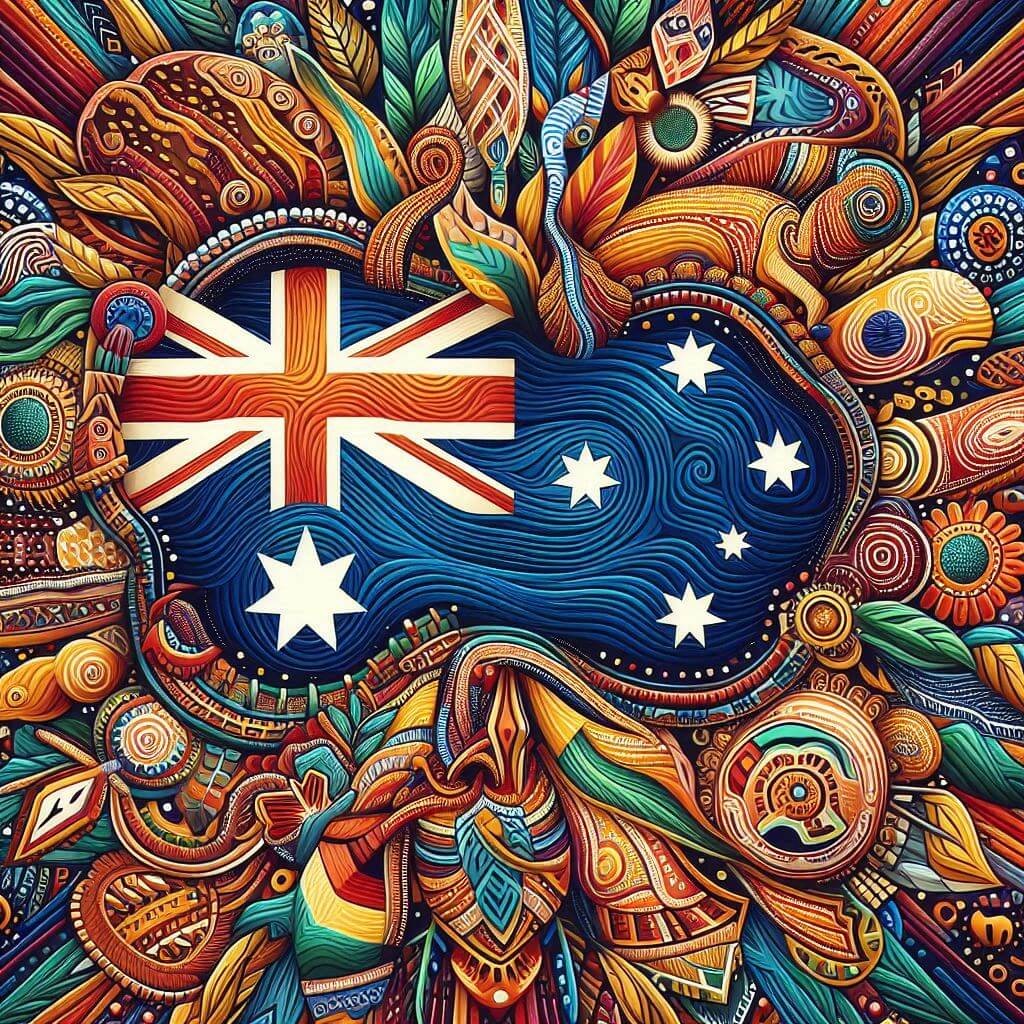The flag of Australia is a distinctive and iconic symbol that encapsulates the nation's history, cultural heritage, and unique geographical position. It features a blue field with the Union Jack occupying the upper hoist quarter (canton), a large white seven-pointed star known as the Commonwealth Star below the Union Jack, and five smaller white stars on the fly half forming the constellation of the Southern Cross. This design, rich in symbolism, represents Australia's past, present, and aspirations for the future.
Australia information
| National Flag Day | September 3 |
| Sovereign state | Yes |
| Official name | Commonwealth of Australia |
| Capital | Canberra |
| Population | 25,950,126 |
| Area | 7,686,850 km² |
| Currency | Australian dollar (AUD) |
| Language | English |
| Continent | Oceania |
| Region | Australasia |
| Subregion | Melanesia |
| Borders | — |
| Timezone | UTC+8 to UTC+10.5 |
| Calling code | +61 |
| Top-level domain | .au |
History and Evolution of the Australian Flag
 The current Australian flag was officially adopted on September 3, 1901, shortly after the Federation of Australia on January 1 of the same year. Its design was the result of a public competition announced in April 1901, which attracted over 32,000 entries from around the world. The winning design was based on the British Blue Ensign, modified to represent Australia's unique identity.
The current Australian flag was officially adopted on September 3, 1901, shortly after the Federation of Australia on January 1 of the same year. Its design was the result of a public competition announced in April 1901, which attracted over 32,000 entries from around the world. The winning design was based on the British Blue Ensign, modified to represent Australia's unique identity.
Prior to 1901, various flags were used across the Australian colonies, including the Union Jack and different versions of the British Red and Blue Ensigns. The adoption of a single national flag was a significant step in forging a unified Australian identity.
While the basic design has remained unchanged since 1901, there have been minor modifications:
- In 1908, a seventh point was added to the Commonwealth Star to represent the territories of Australia.
- In 1954, the Flags Act formally established the current design as the official flag of Australia.
Symbolism and Design of the Australian Flag
Every element of the Australian flag carries deep symbolic meaning:
- The Blue Ensign: The blue background, or field, is derived from the British Blue Ensign, reflecting Australia's historical ties to the United Kingdom.
- The Union Jack: Positioned in the canton, it represents Australia's historical origins as a group of British colonies and its ongoing membership in the Commonwealth of Nations.
- The Commonwealth Star: Also known as the Federation Star, this large seven-pointed star beneath the Union Jack symbolizes the Federation of Australia. Six points represent the six original states, while the seventh point represents the territories of Australia and any future states.
- The Southern Cross: The five stars on the fly of the flag depict the constellation of the Southern Cross, visible from all of Australia's states and territories. It consists of four seven-pointed stars and one five-pointed star. The Southern Cross has been used to represent Australia since the early days of British settlement and is significant in Aboriginal astronomy.
Usage and Significance of the Australian Flag
 The Australian flag serves as a powerful symbol of national identity and unity. It is prominently displayed on government buildings, schools, and public institutions across the country. During national holidays and significant events, such as Australia Day (January 26), Anzac Day (April 25), and Australian National Flag Day (September 3), the flag takes center stage in celebrations, commemorations, and official ceremonies.
The Australian flag serves as a powerful symbol of national identity and unity. It is prominently displayed on government buildings, schools, and public institutions across the country. During national holidays and significant events, such as Australia Day (January 26), Anzac Day (April 25), and Australian National Flag Day (September 3), the flag takes center stage in celebrations, commemorations, and official ceremonies.
In international contexts, the Australian flag represents the nation at diplomatic events, United Nations gatherings, and sporting competitions. It's a source of pride for Australian athletes competing in events like the Olympic Games and various World Championships.
The flag also plays a significant role in civic ceremonies, such as citizenship ceremonies, where new Australians pledge their loyalty to their adopted country. It's often used to drape the coffins of servicemen and women, former prime ministers, and other notable Australians during state funerals.
Interesting Facts About the Australian Flag
- The Australian flag is one of the few national flags that can be flown upside down as a distress signal, due to its asymmetrical design.
- The specific shade of blue used in the flag is officially defined as Pantone 280C.
- Australia allows for the official use of several other flags alongside the national flag, including the Aboriginal flag and the Torres Strait Islander flag, recognizing the country's Indigenous peoples.
- The Southern Cross on the flag is arranged to represent its appearance in the night sky, with Epsilon Crucis (the smallest star) being slightly out of line with the others.
- There have been ongoing debates about changing the Australian flag, particularly to remove the Union Jack, but no alternative design has gained widespread support.
- The flag's design has inspired the flags of several other nations and territories in the Pacific, including New Zealand and Fiji.
- The largest Australian flag flown was at the Fremantle Football Club's home ground in Western Australia, measuring 35 meters by 70 meters.